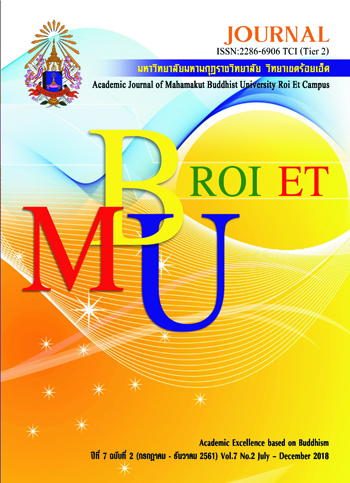The Development Approach of Mahamakut Buddhist University’s curricula concerning the training of morality and ethics for children and youths
Main Article Content
Abstract
The objectives of the research were 1) to study the present development of Mahamakut Buddhist University’s curricula concerning the training of morality and ethics for children and youths, 2) to synthesize the guidelines for developing the curricula concerning the training of morality and ethics for children and youths, and 3) to develop the curricula about the training of morality and ethics for children and youths through the theory of Galen L. Saylor and William M. Alexander. The samples were 291 in number, which were selected via the simplistic sampling process, comprising the executives, trainers/assistant trainers and training staff members. The research process was implemented in four steps : 1) synthesis of Mahamakut Buddhist University’s curricula regarding the training of morality and ethics for children and youths; 2) empirical study, 3) exploratory factor analysis (EFA) and confirmatory factor analysis (CFA), and 4) summary and evaluation. The computer program was employed to analyze the collected data with statistical tools including mean, standard deviation, EFA and CFA.
The research results were as follows:
1. The present development of MBU curricula as regards to the training of morality and ethics for children and youths was found, in an overall aspect, to stand at the ‘MUCH’ level. In an individual aspect, the item that bearing the highest mean was assessment and evaluation, followed by curriculum implementation, goal, target and framework setting, and curriculum design, respectively.
2. The guidelines for development of the said curricula were synthesized into four categories beginning with 1) setting goal, target and framework, 2) designing, 3) implementing and 4) assessing and evaluating, respectively.
3. The four guidelines for development of the said curricula encompassed 50 indicators, i.e., 13 indicators for curriculum design; 11 indicators for goal, target and framework setting; 13 indicators for implementation and 13 indicators for assessment and evaluation.
Article Details
References
สำนักงานเลขาธิการสภาการศึกษา. (2551). ยุทธศาสตร์การพัฒนาคุณภาพการศึกษา : ระเบียบวาระแห่งชาติ(พ.ศ. 2551-2555). กรุงเทพฯ : พริกหวานกราฟฟิค.
สุนีย์ ภู่พันธ์. (2546). แนวคิดพื้นฐานการสร้างและการพัฒนาหลักสูตรยุคปฏิรูปการศึกษาไทย. เชียงใหม่ : The Knowledge Center.
สุภมาศ อังศุโชติ และคณะ. (2551).สถิติวิเคราะห์สำหรับการวิจัยทางสังคมศาสตร์และพฤติกรรมศาสตร์ : เทคนิคการใช้โปรแกรม LISREL. กรุงเทพฯ : บริษัทมิสชั่น มีเดีย จำกัด.
อรสา ปราชญ์นคร. (2523). หลักสูตรและแบบเรียนมัธยมศึกษา. กรุงเทพฯ : ไทยวัฒนาพานิช.
Tyler, Ralph W. (1930). Basic Principles of curriculum and Instruction. Chicago : The University of Chicago press.


